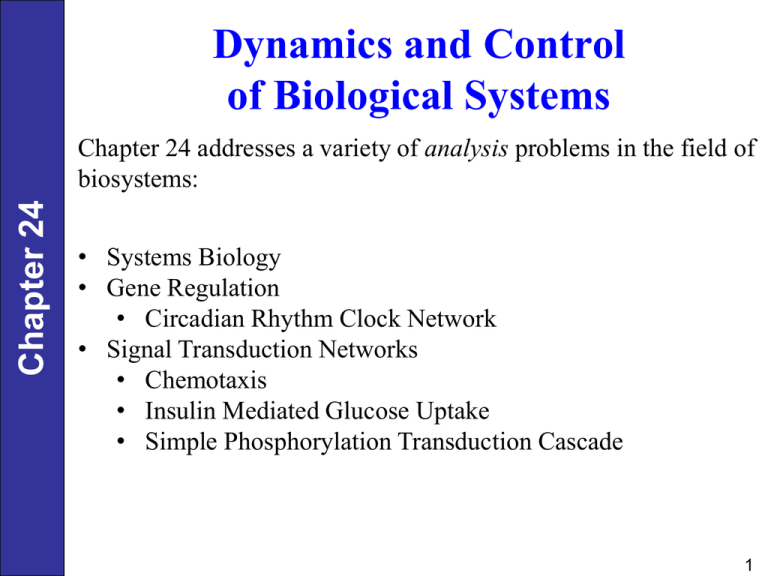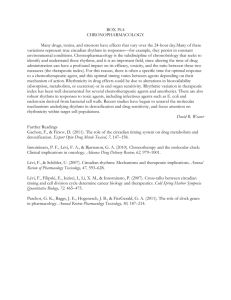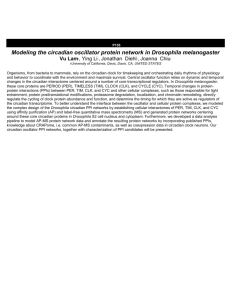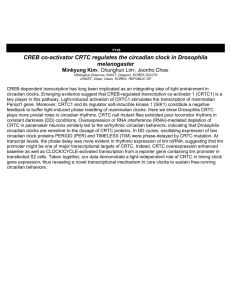Chapter 24
advertisement

Dynamics and Control of Biological Systems Chapter 24 Chapter 24 addresses a variety of analysis problems in the field of biosystems: • Systems Biology • Gene Regulation • Circadian Rhythm Clock Network • Signal Transduction Networks • Chemotaxis • Insulin Mediated Glucose Uptake • Simple Phosphorylation Transduction Cascade 1 What is “Systems Biology”? [WTEC Benchmark Study (2005): M. Cassman, A. Arkin, F. Doyle, F. Katagiri, D. Lauffenburger, C. Stokes] [also: Nature, Dec 22, 2005] 15 Chapter24 Chapter Primary Definition: The understanding of biological network behavior through the application of modeling and simulation, tightly linked to experiment Related Ideas – Identification and validation of networks – Creation of appropriate datasets – Development of tools for data acquisition and software Motivation: Phenotype is governed by the behavior of networks, rather than the operation of single genes. Understanding the dynamics of even the simplest biological networks requires the application of modeling and simulation. 2 15 Chapter24 Chapter s32 Synthesis + + s32 Synthesis of Heat Shock Proteins (FtsH and DnaK) HEAT Folding Process Folded Protein DNAK Binding to s32 Figure 24.1 Feedback and feedforward control loops that regulate heat shock in bacteria (modified from El-Samad, et al., 2006). 3 Phosphorylation & Dimerization of PER, CRY 15 Chapter24 Chapter PER Translation CRY Translation per Transcription cry Transcription LIGHT Nucleus Cytoplasm Cell Membrane Figure 24.2 The gene regulatory circuit responsible for mammalian circadian rhythms. 4 15 Chapter24 Chapter Transcription primary transcript Nuclear Transport mRNA Translation protein Protein Activation active protein Nucleus Cytoplasm Cell Membrane Figure 24.3 The layers of feedback control in the Central Dogma (modified from (Alberts et al., 1998)) 5 Multi-Component Loop Autoregulation Feedforward Loop G2 G1 TF1 TF1 TF1 TF2 G1 TF2 15 Chapter24 Chapter G1 SIMO Module MIMO Module TF1 G1 G2 G2 TF1 G3 TF2 G1 G2 G3 Regulator Chain TF1 G1 TF2 G2 TF3 G3 Figure 24.4 Examples of circuit motifs in yeast (adapted from (Lee et al., 2002)). The rectangles denote promoter regions on a gene (G1, G2, etc.) and the circles are transcription factors (TF1, TF2, etc.). 6 15 Chapter24 Chapter Process Control Concept Biological Control Analog Sensor Concentration of a protein Setpoint Implicit: equilibrium concentration of protein Controller Transcription factors Final control element Transcription apparatus; ribosomal machinery for protein translation Process Cellular homeostasis Table 24.1 Analogies between process control concepts and gene transcription control concepts. 7 15 Chapter24 Chapter Circadian Rhythms Circadian rhythms = self-sustained biological rhythms characterized by a free-running period of about 24h (circa diem) Circadian rhythms characteristics: • General – bacteria, fungi, plants, flies, fish, mice, humans, etc. • Entrainment by light-dark cycles (zeitgeber) • Phase shifting by light pulses • Temperature compensation Circadian rhythms occur at the molecular level 8 Drosophila Circadian Oscillator PER DBT P 15 Chapter24 Chapter PER P PER TIM P PER TIM TIM P per tim Nucleus DBT TIM Cytoplasm 9 LIGHT Phosphorylation & Dimerization of PER, TIM TIM Degradation PER Translation 15 Chapter24 Chapter TIM Translation per Transcription tim Transcription Nucleus Cytoplasm Cell Membrane LIGHT Transcription Process mRNA(M) Translation and Degradation Processes Protein (P) Figure 24.5 Schematic of negative feedback control of Drosophila circadian clock (adapted from (Tyson et al., 1999)): detailed system (top), and simplified model (bottom). 10 2 1 0 0 20 40 60 80 100 80 100 Time (h) 4 Protein 15 Chapter24 Chapter mRNA 3 3 2 1 0 0 20 40 60 Time (h) Figure 24.6 Simulation of the circadian clock model. 11 mRNA 4 3 2 1 0 20 40 60 80 100 80 100 Time (h) 6 Protein 15 Chapter24 Chapter 0 4 2 0 0 20 40 60 Time (h) Figure 24.7 Simulation of circadian clock model for varying values of nm (1.0 (solid), 1.1 (dashed), 1.5 (dash-dot), 2.0 (dotted), 4.0 (asterisk)). 12 mRNA 4 2 0 0 50 100 150 200 250 300 350 400 250 300 350 400 250 300 350 400 Protein 5 0 0 50 100 150 200 Time (h) Keq 15 Chapter24 Chapter Time (h) 200 100 0 50 100 150 200 Time (h) Figure 24.8 Simulation of circadian clock model for entraining signal with period of 20 h. 13 15 Chapter24 Chapter Implications from Systems Biology Studies • Robustness characteristics of feedback architecture under stochastic uncertainty • Underlying design principles • Nature of entrainment, and systems characterization • Possible therapeutic ramifications (mutants, etc.) • General biological oscillator insights 14 15 Chapter24 Chapter Bacterial Chemotaxis Process by which motile bacteria sense chemical gradients and move in favorable directions E. coli alternates between: – Smooth runs (flagella spin counterclockwise) – Tumble (flagella spin clockwise) [wikipedia] Random walk that is biased towards chemical gradient Impossible to detect gradient across length of body Key property: perfect adaptation – Steady-state tumbling frequency in uniform environment is independent of environment concentration level 15 LIGAND CheW-CheA CheW-CheA methylation demethylation CheR 15 Chapter24 Chapter Y dephosphorylation CheZ B CheY dephosphorylation CheB Y phosphorylation B phosphorylation CheYp CheBp Cell Membrane Motor (tumble) Figure 24.9 Schematic of chemotaxis signaling pathway in E. coli (adapted from Rao et al., 2004). 16 y0 15 Chapter24 Chapter u K + + -x + + y -1 s Figure 24.10 Integral control feedback circuit representation of chemotaxis (adapted from Yi et al., 2000). 17 15 Chapter24 Chapter Insights Gained from Systems Biology Approach • Study reveals that robustness facilitates analysis (specific parameters not required, module can be isolated) • Robustness properties point to reliable performance over environmental perturbations or mutations – suggesting preference for evolution • Rao et al. study points to limitations in homologous gene analysis • Narrowly tuned ranges are often key for homeostasis, and integral control can help attain such performance • Integral control leads to robustness in biochemical networks 18 15 Chapter24 Chapter Type 2 Diabetes Mellitus A metabolic disorder primarily characterized by hyperglycemia and insulin resistance US: 14 million with associated annual medical costs of $132 billion Worldwide: 350 million by the year 2030 Linked to obesity due to high caloric intake combined with low physical activity – progresses through insulin resistance 19 INSULIN RECEPTOR 15 Chapter24 Chapter Insulin Receptor Dynamics Signal Transduction Cascade CheZ Glucose Transporter Biomechanics Cell Membrane GLUT4 Figure 24.11 Simplified insulin signaling pathway for glucose uptake. 20 15 Chapter24 Chapter Insulin-Stimulated GLUT4 Translocation Model 21 15 Chapter24 Chapter Figure 24.12 Schematic of 4th order signal transduction cascade for Example 24.3, combined with first-order receptor activation (adapted from Heinrich et al., 2002). 22





